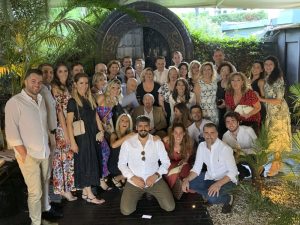A historian and a linguist, working together, revealed new truths about the relationship between Spanish colonizers and the Timucua people
In this page from Confessionario En lengua Castellana y Timuquana Con algunos consejos para animar al penitente (Confessions in the Castilian and Timucua Language, with some tips to encourage the penitent.), Spanish is at left and the translation of Timucua is at right. Collections of the John Carter Brown Library, Brown University.
When historian Alejandra Dubcovsky was in graduate school in the early 2000s, she decided to focus her research on the Indigenous cultures of the Americas. “I asked my professors, ‘Should I learn any Native languages?’” Dubcovsky recalled. “And they were like, ‘Why? You know Spanish, you know French—you’re set for life.’” Dubcovsky laughed. “And I went to Berkeley!”
Dubcovsky’s teachers were just repeating what their own mentors had told them: Native languages were too hard to learn, and most pre-Columbian cultures didn’t leave behind written records anyway. Some, like the Aztec and Maya, had hieroglyphic systems, but those symbols offered little insight into the spoken languages themselves. Why shouldn’t Dubcovsky, who was born in Argentina, just study the records of Spanish colonizers the way generations before her had done?
When she connected with Aaron Broadwell, a linguistics professor at the University of Florida, she found the missing puzzle pieces she had been seeking. Broadwell was an expert on the Native languages of the American Southeast—Choctaw, Creek and others that belonged to the Muskogee family. His most ambitious project was decoding a language, spoken by the Timucua people, that is unrelated to any other known tongue.
When Spanish colonizers arrived in the 16th century, Timucua was the most widely spoken language in large swaths of Florida and Georgia. Within two centuries, by the time of U.S. independence, its speakers had all been enslaved, felled by disease or absorbed into other language groups. Despite its diminishment, Timucua left a record—it was the first Native language within modern U.S. borders to be put into writing, albeit using the Roman alphabet. Rare book libraries hold Franciscan texts that display Spanish on one side and Timucua on the other. Most historians just read the Spanish side. But Dubcovsky wanted to know what the Timucua texts really said.
Since around 2000, Broadwell has been assembling the first comprehensive online Timucua dictionary, with the help of graduate students and computer programs that can search for patterns in grammar and meaning. Together, he and Dubcovsky have also made a number of startling new discoveries that challenge the usual narrative about how the Timucua language came to be written down.
Those of us at Smithsonian repeated a version of that narrative in our March issue, briefly crediting the Franciscan missionary Francisco Pareja with transcribing the Timucua language into the Roman alphabet. That version of the story, with Pareja at the center, has been widely promulgated for generations. As a catalogue entry at the Library of Congress puts it: “Timucuan is a dead language. Spoken by an Indigenous tribe that lived in northeast-north central Florida during the time of Spanish colonization, it was learned and recorded by Friar Francisco Pareja, a missionary and self-taught linguist. Thanks to his efforts, Timucua is now considered the best-attested language from a Native tribe in Spanish Colonial Florida.”
After our issue appeared in print, we received a letter from a reader—historian Denise Bossy from the University of North Florida—urging us to reach out to Broadwell and Dubcovsky. So we did.
“It’s not that your answer was wrong exactly,” Dubcovsky told us over Zoom from the University of California, Riverside, where she now teaches history. That is, the Spanish missionaries did indeed teach the Roman alphabet to the Timucua people for religious purposes. What was missing, says Dubcovsky, is the role that the Timucua had in authoring the first Timucua texts.
Broadwell chimed in from Florida in another Zoom square. “The traditional understanding of the way this works is that the missionary appears and learns the language and then translates the stuff himself,” he said. “But if we look closely at the text, we can see that it didn’t happen that way.”
He gave an example. The Spanish texts are filled with leading questions, phrased in a way that implied Timucua traditions were sinful superstitions. “Did you make incantations over the lake before fishing in it?” one asks. “When the owl was screeching, did you believe that it would have mercy on you?” asks another.
But not all the questions are translated word for word. “The Spanish side will say something like, ‘Do you engage in the devilish practice of whistling to the wind to make the storm stop?’” said Broadwell. “And the Timucua just says, ‘Did you whistle to the wind to make it stop?’” This happens frequently, Broadwell said: The Timucua side rephrases the Franciscan questions in ways that are considerably less judgy.
All of this strongly implies that members of the Timucua community were the ones writing these translations in the Roman alphabet. “Our favorite is the description of marriage,” Dubcovsky said. “The Spanish side asks very clearly, ‘Have the man and a woman been joined together in front of a priest?’ And the Timucua version of that sentence is, ‘Did you and another person consent to be married?’” The Timucua translation not only takes out any mention of gender, but it also removes any mention of a religious officiant. “A priest did not write this,” Dubcovsky said, “because a priest does not forget to include himself in the story.”
It makes sense, she added, that a Franciscan Spaniard wouldn’t have understood enough of the language to write or even proofread the Timucua translation before he sent the manuscript off to Mexico City to be printed at the region’s nearest printing press. “It’s very hard to learn these languages, and Native people don’t want to share everything,” Dubcovsky pointed out. “And those translators aren’t given any credit.”
Throughout the 17th century, the Timucuas kept using the alphabet they’d learned from the Spanish to send each other letters in their own language, sharing concerns about land and water rights and lamenting the Spaniards’ broken promises. Only two of those letters survive—one from 1651 and one from 1688—but their existence indicates that the Timucuas kept on writing within their own community long after their project with the priests was finished.
Going straight to those sources allows scholars to learn about the Timucuas on their own terms, says Dennis Zotigh, a cultural specialist at the Smithsonian’s National Museum of the American Indian. “Ever since contact, colonial powers have been interpreting the written word in their own languages to describe the Western Hemisphere cultures they came in contact with,” says Zotigh, a member of the Kiowa Tribe who also has tribal affiliations with the Isanti Dakota and Ohkay Owingeh Pueblo tribes. “Times have changed. Now researchers and Native peoples are assuming the power of the pen to rewrite Native history from a more informed perspective.”
In the case of Broadwell and Dubcovsky, they’ve unlocked sources that had long been abandoned as indecipherable. Their breakthroughs would have been impossible without their pooled knowledge of history and linguistics. In 2017, the two researchers jointly published a paper in the journal Early American Studies. They also spoke at a recent meeting of the American Historical Association, advocating for more joint work between their fields. After all, it would be unthinkable to have a Classics department whose speakers didn’t bother to read the original texts from Greece and Rome—or a scholar of Greek and Latin who wasn’t well-versed in ancient history. “Their collaboration is unique and compelling,” says Robbie Etheridge, a University of Mississippi anthropologist who is a leading expert on Indigenous history in the Southern United States. “It will inspire others to engage in similar collaborations.”
As Broadwell and Dubcovsky restore credit to Timucua authors, they’re raising some intriguing questions. For example, did the Timucuas who worked with the Spanish priests really embrace Christianity, or was their sly rewording an act of resistance?
“There’s a little bit of everything,” said Dubcovsky. “Do I think some Indigenous people in the 16th century are fully converting and finding peace and salvation in this new faith? Absolutely. Do I also think some people are skirting the line and trying to contain their own autonomy and spaces within that? Also absolutely.” Broadwell added that some of the Timucua translators might been wording things extra carefully “so as not to offend all the non-Christian members of their community.”
Another question: Why didn’t more Native people develop writing before European colonizers showed up, considering how readily they took to it? (Most Native American languages have written forms today.) “Alphabets are kind of rare,” Broadwell replied. In all of human history, systems of writing have emerged in just a handful of places—in Egypt and Mesoamerica, in China, in Babylon, in Korea. And most of these weren’t phonetic alphabets with consonants and vowels. “That has happened maybe only once in the history of the world,” said Broadwell, alluding to the Proto-Sinaitic script from ancient Canaan that dates between the 16th and 19th centuries B.C.E., “and all other alphabets were descendants of that one.”
If Indigenous groups didn’t start writing things down before the Europeans came along, maybe it’s because they didn’t need to. “The difference between a written and an unwritten language is pretty small,” Broadwell said. “Timucua was a fully formed, eloquent spoken language before the Spanish came along. From the very beginning of the written record, we can see that the language is extremely sophisticated.” There’s plenty of evidence that the Timucua were able to travel and communicate about complex issues: Even though their language is unique, its structure bears some similarities to Choctaw, suggesting that the two groups interacted and influenced each other.
Dubcovsky also noted that it’s not correct to call either the language or its speakers extinct today. Over time, many Timucua people certainly left the region. “People don’t stay in places where they’re dying or suffering,” she said. “We used to think the Timucuas moved north and west, but I’m increasingly convinced that they mostly moved south. Some of their descendants might identify as Cuban or as African American. Or maybe they identify as members of another tribe. But they’re still with us.”
So is their language—thanks in large part to unknown Native authors who adopted a new alphabet and found ways to preserve their own voices within a changing world.
Get the latest History stories in your inbox?
Recommended Videos
Reviving the Ohlone Language
Using archived ethnographic research, Linda Yamane is bringing back the language of the Ohlone, a Northern California tribe




